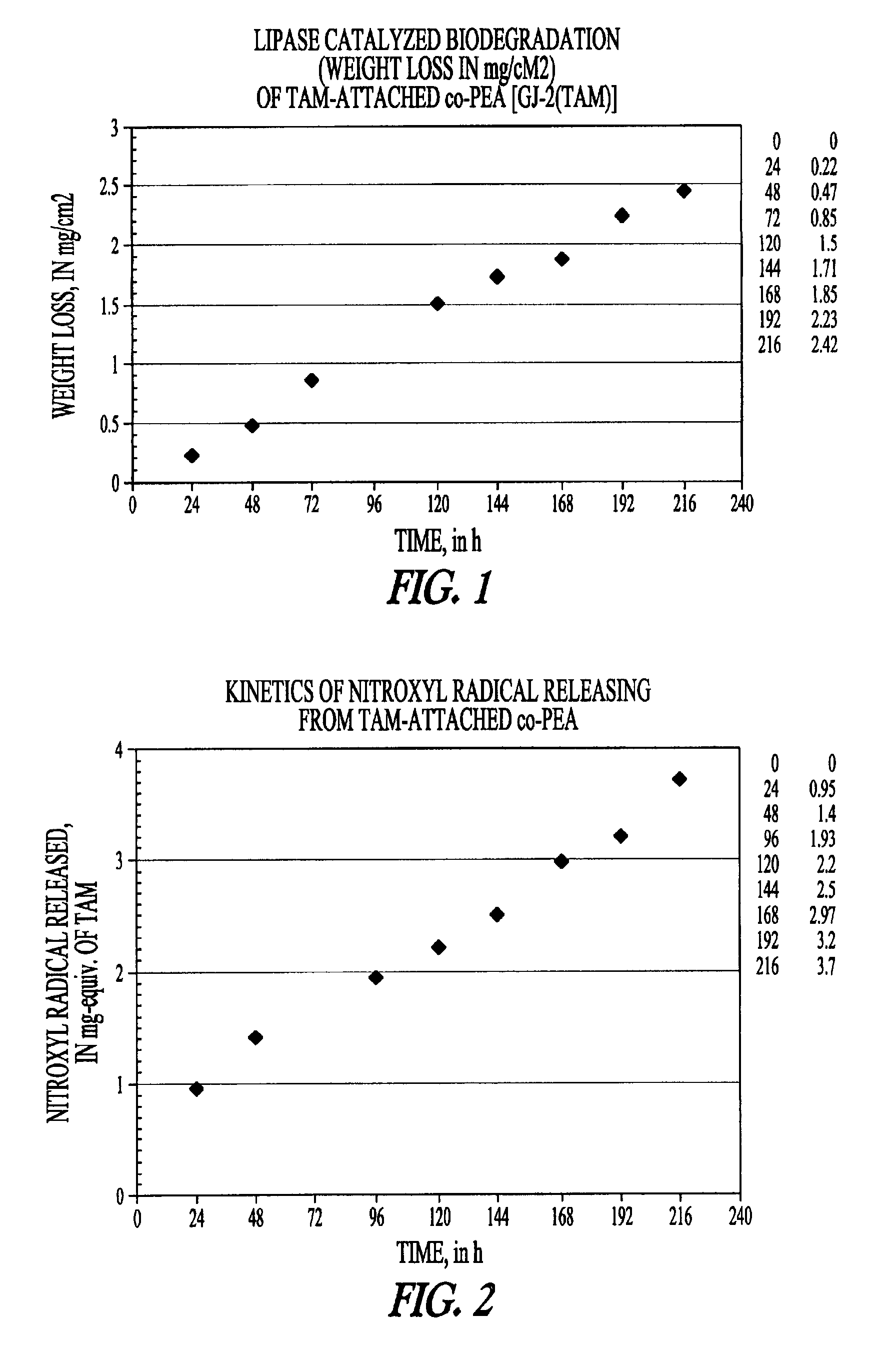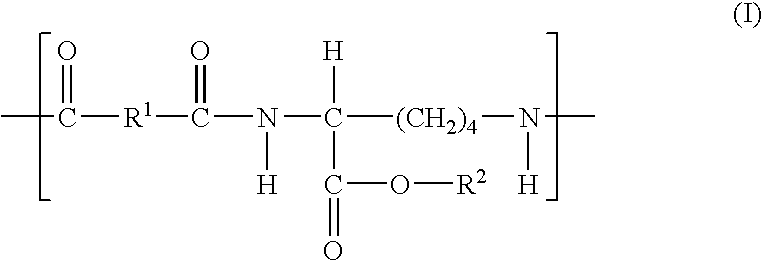Elastomeric functional biodegradable copolyester amides and copolyester urethanes
a biodegradable, elastomeric technology, applied in the direction of peptides, drug compositions, prosthesis, etc., can solve the problems of inability to synthesize many conventional poly(-amino acids) and many undesirable physical, chemical and biodegradation properties, and relatively few attempts to synthesize polyisopeptides, etc., to facilitate wound repair of injured tissues, suppress inconsolable cell proliferation, and increase hemocompatibility
- Summary
- Abstract
- Description
- Claims
- Application Information
AI Technical Summary
Benefits of technology
Problems solved by technology
Method used
Image
Examples
example 1
[0285]Preparation of co-poly-{[N,N′-adipoyl-bis-(L-leucine)-1,6-hexylene diester]}0.75-{[N,N′-adipoyl-L-lysine benzyl ester]0.25} (1) (compound of formula (VII) wherein m=0.75, p=0.25, n=75, R1=(CH2)4, R2=Bz, R3=iso-propyl and R4=(CH2)6).
[0286]Dry triethylamine (30.8 mL, 0.22 mole) was added to the mixture of the di-p-toluenesulfonic acid salt of bis-(L-leucine)-1,6-hexylene diester (III, R4 (CH2)6) (50.168 g, 0.075 mole); the di-p-toluenesulfonic acid salt of L-lysine benzyl ester (IV) (total amount of (III)+(IV)=0.1 mole) (14.518 g, 0.025 mole); and di-p-nitrophenyl adipate (V, R1=(CH2)4) (38.833 g, 0.1 mole) in dry N,N-dimethylacetamide (52.5 mL) (total volume of DMA and NEt3 is 83.3 mL, concentration 1.2 mol / L by (III)+(IV) or by (V)) at room temperature. Afterwards, the temperature of the reaction mixture was increased to about 80° C. and stirred for about 16 hours. The viscous reaction solution was cooled to room temperature, diluted with ethanol (150 mL), and poured into wate...
example 2
[0287]Preparation of co-poly-{[N,N′-sebacoyl-bis-(L-leucine)-1,6-hexylene diester]}0.75-{[N,N′-sebacoyl-L-lysine benzyl ester]0.25} (2) (compound of formula (VII) wherein m=0.75, p=0.25, n=65, R1=(CH2)8, R2=Bz, R3=iso-propyl, and R4=(CH2)6).
[0288]Dry triethylamine (30.8 mL, 0.22 mole) was added to the mixture of di-p-toluenesulfonic acid salt of bis-(L-leucine)-1,6-hexylene diester (III, R4=(CH2)6) (50.168 g (0.075 mole); the di-p-toluenesulfonic acid salt of L-lysine benzyl ester (IV) (14.518 g, 0.025 mole) (total amount of (III)+(IV)=0.1 mole), and di-p-nitrophenyl sebacinate (V, R1=(CH2)8) (44.444 g, 0.1 mole) in dry N,N-dimethylacetamide (DMA) (52.5 mL) (total volume of DMA and NEt3 is 83.3 mL, concentration 1.2 mol / L by (III)+(IV) or by (V)) at room temperature. Afterwards, the temperature of the reaction mixture was increased to about 80° C. and stirred for about 16 hours. The viscous reaction solution was cooled to room temperature, diluted with ethanol (150 mL), and poured i...
example 3
[0289]Preparation of co-poly-{[N,N′-adipoyl-bis-(L-leucine)1,6-hexylene diester]}0.50-[N,N′-adipoyl-bis-(L-phenylalanine)-1,6-hexylene diester]0.25-{[N,N′-adipoyl-L-lysine benzyl ester]0.25} (3) (compound of formula (VII) wherein m=0.50, p=0.50, R1=(CH2)4, R2=Bz, R3=iso-propyl and Bz, and R4=(CH2)6 and Bz).
[0290]Dry triethylamine (30.8 mL, 0.22 mole) was added to the mixture of the di-p-toluenesulfonic acid salt of bis-(L-leucine)-1,6-hexylene diester (III, R4 (CH2)6) (34.446 g, 0.050 mole), the di-p-toluenesulfonic acid salt of bis-(L-phenylalanine)1,6-hexylene diester (III, R4=CH2Ph) (18.924 g, 0.025 mole), the di-p-toluenesulfonic acid salt of L-lysine benzyl ester (IV) (14.5180 g, 0.025 mole) (total amount of (III)+(IV)=0.1 mole), and di-p-nitrophenyl adipate (V, R1=(CH2)4) (38.833, 0.1 mole) in dry N,N-dimethylacetamide (DMA) (52.5 mL of) (total volume of DMA and NEt3 is 83.3 mL, concentration 1.2 mol / L by (III)+(IV) or by (V)) at room temperature. Afterwards, the temperature o...
PUM
| Property | Measurement | Unit |
|---|---|---|
| length | aaaaa | aaaaa |
| temperature | aaaaa | aaaaa |
| time | aaaaa | aaaaa |
Abstract
Description
Claims
Application Information
 Login to View More
Login to View More - R&D
- Intellectual Property
- Life Sciences
- Materials
- Tech Scout
- Unparalleled Data Quality
- Higher Quality Content
- 60% Fewer Hallucinations
Browse by: Latest US Patents, China's latest patents, Technical Efficacy Thesaurus, Application Domain, Technology Topic, Popular Technical Reports.
© 2025 PatSnap. All rights reserved.Legal|Privacy policy|Modern Slavery Act Transparency Statement|Sitemap|About US| Contact US: help@patsnap.com



